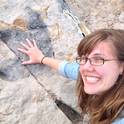The phylogenetic relationships of Paleozoic blastozoan echinoderms are poorly understood and many of the traditionally ascribed groups are likely polyphyletic. Diploporitans, those blastozoans with double pore (diplopore) respiratory structures, have never been placed within a rigorous phylogenetic framework, and their highly variable morphologies suggest that they do not represent a natural clade. A maximum parsimony phylogenetic analysis, spanning a wide range of diploporitan and related taxa, indicates that diplopore-bearing blastozoans are a polyphyletic grouping and, consequently, that diplopore respiratory structures have evolved more than once within the echinoderms. Constraint analyses indicate that a single diplopore-bearing clade bearing the traditionally defined Glyptosphaeritida, Sphaeronitida, Asteroblastida is less parsimonious than multiple diplopore-bearing clades inferred by the unconstrained analysis.
Journal of Paleontology, in press, 13 p.
Available at: http://works.bepress.com/sarah-sheffield/8/
